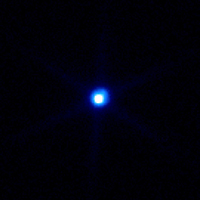Astronomy Picture of the Day
Discover the cosmos! Each day a different image or photograph of our fascinating universe is featured, along with a brief explanation written by a professional astronomer.
Posted on 02/01/2003 4:01:10 AM PST by petuniasevan
Discover the cosmos! Each day a different image or photograph of our fascinating universe is featured, along with a brief explanation written by a professional astronomer.
Explanation: The lonely RX J1856.5-3754 was formed from the collapsed core of an exploding star. At a distance of 180 light-years it is the closest known neutron star. More massive than the Sun but only 20 kilometers across, this tiny stellar juggernaut plows through the hydrogen gas and dust clouds of interstellar space at about 200 kilometers per second. The surface of the neutron star is fantastically hot, around 700,000 degrees Celsius, making it detectable with orbiting x-ray telescopes. But optical astronomers were surprised to discover that RX J1856.5-3754 is also surrounded by a cone-shaped nebula. Indicated in this deep image from the European Southern Observatory's Kueyen telescope, the nebula glows in the red light of ionized hydrogen atoms recombining with electrons. Its cone shape is analogous to the bow wave of a ship plowing through water. A faint blue dot near the tip of the cone is the neutron star itself. The nebula appears to have formed very near the surface of the neutron star and astronomers are trying to determine if the observed densities and temperatures can explain the nebula's appearance.

It's strange that the APOD editors make no mention of the possibility that this object is actually a quark star.
A MUST-SEE Link:

Caption: False-colour composite photo of the sky field with the lonely neutron star RX J1856.5-3754 and the related cone-shaped nebula. It is based on a series of exposures obtained with the multi-mode FORS2 instrument at VLT KUEYEN through three different optical filters: R (29 exposures of 136 sec each; ~1.1 hrs total; here rendered as green); H-alpha (19; 1020 sec; ~5.5 hrs; red); and B (10; 138 sec; ~0.4 hrs; blue). The seeing was good to excellent during the exposures (0.66 arcsec on average). The trails of some moving objects, most likely asteroids in the solar system, are seen in the field with intermittent blue, green and red colours. The large field (PR Photo 23a/00) measures 6.6 x 6.7 arcmin2, with 0.2 arcsec/pixel. For clarity, a smaller area around the neutron star and the cone ("bowshock") nebula has been enlarged in PR Photo 23b/00. The object is at the centre of the circle and the neutron star is indicated with an arrow; the field measures 80 x 80 arcsec2. North is to the lower right and East is upper right. The motion of the neutron star as seen on the sky (see the text) is towards East, exactly in the direction indicated by the nebula.
Disclaimer: Opinions posted on Free Republic are those of the individual posters and do not necessarily represent the opinion of Free Republic or its management. All materials posted herein are protected by copyright law and the exemption for fair use of copyrighted works.